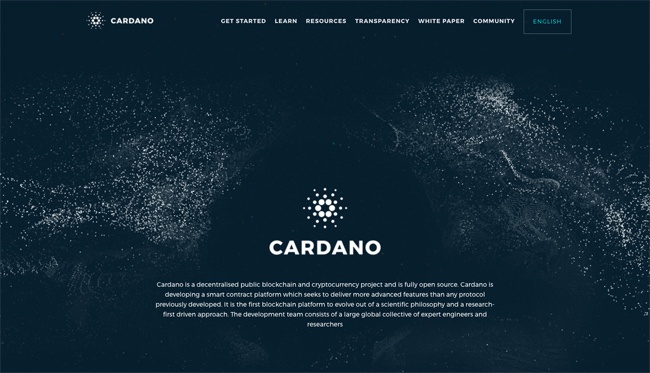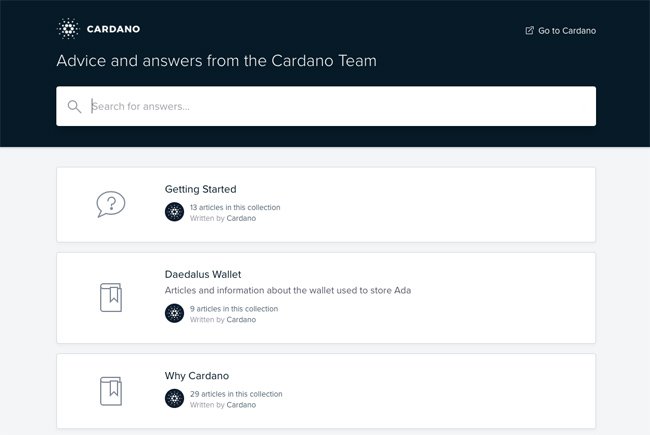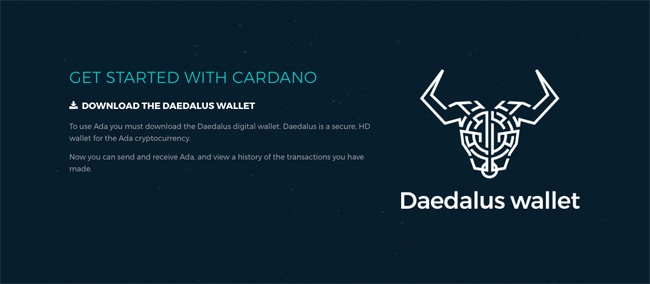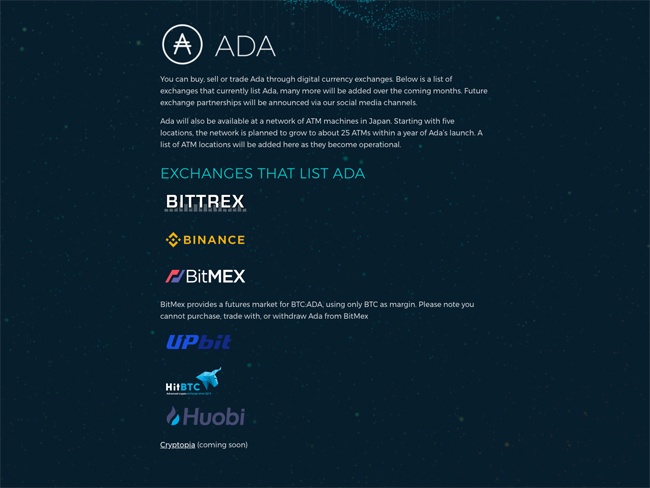Cardano was intended as a complete cryptocurrency, capable of performing the functions of fiat currencies, overcome the challenges that confront the global payment system and even those that other digital currencies have encountered. More than just a cryptocurrency, Cardano was designed to serve as a technology platform that lets users run every-day financial applications used by governments, individuals, and companies around the world.
Cardano is an open source platform that is much the same as Ethereum. ADA is the coin of the Cardano platform and serves as a representation of its digital currency. ADA is named after Ada Lovelace, the first computer programmer, and 19th-century mathematician. The Cardano platform was built from the ground up using a computer language known as Haskell, while ADA runs on its own blockchain which is known as the Cardano Settlement Layer (CSL). Besides the computing layer that powers ADA, Cardano also has a separate layer that is dedicated to smart contracts.
Smart contracts are programs that are built to execute things by themselves on the blockchain with little or no direct human control. Cardano’s Smart Contract language is called Plutus. Plutus is just a lighter version of Haskell and is fashioned to enable adopters to write decentralized applications (DApps) in languages like C++, Java, as well as JavaScript.
Cardano makes use of a decentralized public blockchain to allow users to send and receive tokens from each other. Cardano relies on the Ouroboros, a PoS consensus algorithm for security. Beyond that, Cardano aims to help users open themselves to new opportunities and possibilities by enabling them to become a part of an expanded “world” through “smart contracts.”
Developed and built by a group of top academics, Cardano’s blockchain was the first to evolve out of scientific philosophy. The research that went into its development has helped ensured a platform that is secure, scalable, and flexible enough for use by members of the public.
Its developers plan to integrate Cardano with all other major digital currencies without resorting to third parties, which often result in issues such as slower confirmation times or high commissions.
Origins of Cardano
Three organizations are working to ensure that the Cardano project achieves its goals of improved security, scalability, governance, and flexibility. These companies include Switzerland-based Cardano Foundation, Emurgo, and Input Output Hong Kong (IOHK).
Much of the development efforts are led by IOHK, an engineering and technology organization that was founded by Charles Hoskinson and Jeremy Wood. Both Hoskinson and Wood were among the early founders of Ethereum before they left to begin IOHK.
Both the Cardano Foundation and Emurgo also have their own missions on the project. The Cardano Foundation, for instance, is responsible for protecting, standardizing, and promoting the Cardano Protocol technology. As a result, its goal is to examine and put forward the rules governing the blockchain and currency, serve as a standards body, as well as to secure, improve, and advance the Cardano ecosystem. It is also responsible for collecting information, educating, and growing the Cardano community.
Emurgo’s role is a different one. The organization considers it its job to develop, promote, and protect businesses and fuse them into Cardano’s ecosystem. Emurgo achieves this goal by investing directly into start-up ventures as well as by expanding business partners who are looking to revolutionize their industries using blockchain.
This prompted Emurgo to set up research and development centers in countries such as South Korea, the Philippines, and Vietnam. The headquarters of Emurgo’s is located in Japan. Emurgo also looks to further the Cardano ecosystem by working with established companies. The organization helps existing companies by executing a blockchain strategy and by building decentralized applications on the Cardano platform on their behalf.
There are also a few teams of academics and developers working on the Cardano project. However, they do so on individual projects. They help to monitor developmental projects and are given new tasks as they complete old projects. These teams work in an interval of two weeks and assist by making small and incremental upgrades to the main Cardano project.
The Challenges of Today’s Remittance Systems
While globalization is driving companies to transact more frequently across borders, the difficulty of moving money across international borders has risen significantly in recent years due to some challenges confronting the global payment systems. This makes it difficult for businesses that work with clients and customers overseas.
More so, today, more and more consumers are using e-commerce m-commerce services to make purchases overseas. A growing number of people now work and live outside their countries of birth. These people also face different challenges when they attempt to send money back home. These problems reduce the ease of doing business and undercut social and economic growth. Some of the difficulties of cross-border payments include:
- Traditional correspondent banking arrangements are costly inefficient: Cross-border fees have been the Achilles heel to international transactions for some time now. People are often reluctant to carry out cross-border payments because of the high transactions fees attached. Besides being too high, these costs are sometimes obscure and unpredictable.
- Correspondent banking is slow: Another impediment to online cross-border transactions is that the traditional systems are not only expensive, but they are also slow. In some cases, it takes as long as one week for transactions to be confirmed. These slow transfer times stifle businesses and can be frustrating for individuals who are looking to carry out transactions fast.
- Foreign currency risk: Traditional foreign exchange transactions carry transaction risks that make cash flows uncertain. Exchange rates are unstable and move very fast. And since payments are not confirmed immediately in traditional payment methods, the amount paid and that received could alter significantly if the receiving currency weakens or the money being sent strengthens over time. This can cause a huge disparity that hurt individual and business incomes. Further, certain currencies are not convertible.
Existing financial institutions, while beneficial, are slow, inefficient, and expensive. This makes them unsuitable to modern business and consumer needs. It is for these reasons that cryptocurrencies like Cardano seek to disrupt the system and replace it with something much more efficient, more secure and less expensive.
Cardano’s Offering
Cardona offers some of the most salient features you will ever come across in the cryptocurrency arena. These make it one of the go-to platform for individuals, businesses, and payment providers. These features include:
- A two-layer system: The Cardano platform is offered in a two-layer settlement system, the Cardano Settlement Layer (CSL) and the Cardano Computer Layer (CCL). CCL is the layer upon which smart contracts are implemented, while CSL is an accounting layer that works like a currency. In this manner, The Cardano Settlement Layer stores and accounts for value. On its part, the CCL, which is still under construction, enables decentralized apps and smart contracts to run independently of the Cardano Settlement Layer. This means that financial organizations, governments, and individuals, among others, can use the CCL to run financial apps. Together, these features make Cardano both a medium of exchange and a store of value. Cardona’s structured layers are updatable and easy to maintain over time.
- The Cardano Wallet: Cardano offers a secure, multiplatform, and hierarchical deterministic wallet known as Daedalus wallet. Users can do anything with the wallet from sending and receiving money to searching for transactions. In addition, the developers intend for the wallet to eventually serve as a multi-currency portfolio, allowing users to store and exchange other digital currencies freely. The first currencies that will be supported by the wallet are Ethereum Classic and Bitcoin.
- Block explorer: Cardano’s block explorer allows users to see the histories of their transactions. the information available through this channel include the time and date a transaction occurred, the amount involved, as well as a sender’s public address.
- Security: If Cardano is a potentially transformative technology, it is its emphasis on security that will enable it to accomplish this goal. The currency has built a reputation as a coin that is focused on security. The platform pays attention to safety via its layered architecture. As a currency that aims to find a middle ground that evens out the need for regulation with the idea of decentralization and confidentiality, it makes sense that Cardona focuses on security. This demonstrates the developers’ belief that both end users and regulators should be at the forefront of their development.
Cardano as a Financial Market Asset
Cardano is not traded on its own. Instead, it is paired against other cryptocurrencies on various exchanges. You can buy, sell, or trade Cardano (ADA) on exchange platforms like Upbit, Bittrex, Binance, Huobi, Gate.io, HitBTC, CoinNest, Coinfalcon, and Abucoins. The digital currency is also paired against fiat currencies such as the USD (ADA/USD) on HitBTC, as well as the South Korean Won (ADA/KRW) on Upbit and CoinNest. Some of the major cryptocurrency pairings involving Cardano include ADA/USDT, ADA/BTC, ADA/ETH, and ADA/BNB.
Consequently, investors who are looking to use ADA as a trading asset on their portfolio can do so by purchasing and selling the coin directly on exchanges. Exchange platforms like BitMEX offer a futures market for the ADA/BTC crypto pairing, using only Bitcoin as margin. However, it is important to bear in mind that you cannot buy, withdraw, or trade with ADA on the BitMex platform. ADA will also be available on some ATMs in Japan.
The Challenges
While it cannot be denied Cardano is a reliable blockchain platform, especially given its unique approach to project development and implementation, there are significant concerns about the Cardano project. These include:
- The project is still in development: The Cardano platform is fast gaining reputation both based on its current abilities and its promises. However, the very technology that makes this great digital currency such an exciting one, the CCL, is still in development, as are some other aspects of the project. On top of that, the date for the release of the smart contract which got everyone so excited about the currency hasn’t been made public yet. This means that Cardano is far from the finished article yet. Decentralized applications (DApps) cannot be developed neither can Initial Coin Offerings (ICOs) be conducted until Cardano is production ready. There’s still a long way to go before Cardano will evolve into the full-fledged, very advanced Smart Contract platform that it is being promoted as. And since Smart Contract is the computation layer of the program, the currency’s potential cannot be maximized until it has been fully released.
- Competition: While the Cardano platform touts itself as being an improvement over other cryptocurrencies, nowhere is the rivalry rifer than between it and Ethereum, for obvious reasons. Cardano has improved several aspects of Ethereum and has showcased solutions to the problems facing many other cryptocurrencies. However, the brains behind the Ethereum project are not willing to accept defeat lying down. The blockchain of the Cardano platform is similar to that of Ethereum. This puts the two in direct contention for both bragging rights and functionality. One of the aspects that put Cardano ahead of Ethereum is its performance and scalability. However, Ethereum is making plans to bridge the gap by implementing advanced scaling solutions of its own. Should Ethereum be able to make the needed changes in time, it may consolidate its place in the decentralized applications (DApp) market long before Cardano becomes fully ready.
- Governance and treasury problems: The complicated nature of the Cardano governance and treasury system is great cause for concern, and thus, limits its potential. Many people are concerned that if a team of users can gain enough power to take over control, they could rig the system to their own benefit. To deal with this program, the team behind the Cardano project will need to carefully come up with a system that prevents this from happening, lest, they encounter a problem that may become insurmountable over time.
Conclusion
It is evident that Cardano is a promising cryptocurrency and technology platform that can achieve a lot in the near future. Its present performance is a good indication of how far it can go in future if appropriately managed. The company has managed to address many of the privacy, scaling, and technological issues facing most of today’s blockchains with aplomb.
Other features that make Cardano stand out include its sophisticated proof of stake (PoS) protocol, security-oriented ground base, a layered foundation that allows Cardano to serve as both a blockchain platform and cryptocurrency, and a distinct governance and treasury system. Cardano inspires confidence in its vast followers thanks to its proactive team of developers and strong support network. More so, the developers seem to have a clear idea of what they aim to achieve.
One of the major issues that people are quick to point to is the fact that the platform is still developing. However, this does not detract from all of the incredible benefits that it brings. The development team over at Cardano is considering the possibility of integrating digital currencies into mobile platforms alongside other developments.
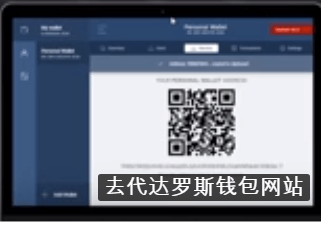
Daedalus Wallet Installation Process (c) Cardano.org
If anything, this points to the fact that Cardano will continue to provide services that solve many significant problems associated with cryptocurrency, especially those that affect the digital currencies that it has similarities of purpose with, such as Ripple and Ethereum. What’s more, Cardano’s programming language is considered to be one of the safest coding languages and is less prone to errors. What is even more exciting is that the program will continue to receive software upgrade on a regular basis.
You may have some reservations, and rightly so, but the one thing that one cannot deny is the fact that exciting times lie ahead for those who are stocking up on as much Cardano as they can.
